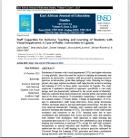| dc.contributor.author | Leah, Sikoyo | |
| dc.contributor.author | Betty, Akullu Ezati | |
| dc.contributor.author | Dianah, Nampijja | |
| dc.contributor.author | Joyce, Ayikoru Asiimwe | |
| dc.contributor.author | Michael, Walimbwa | |
| dc.contributor.author | Daniel, Okot | |
| dc.date.accessioned | 2023-10-30T10:39:23Z | |
| dc.date.available | 2023-10-30T10:39:23Z | |
| dc.date.issued | 2023-10 | |
| dc.identifier.citation | Sikoyo, L., Ezati, B. A., Nampijja, D., Asiimwe, J. A., Walimbwa, M., & Okot, D. (2023). Staff Capacities for Inclusive Teaching and Learning of Students with Visual Impairment: A Case of Public Universities in Uganda. East African Journal of Education Studies, 6(3), 174-191. | en_US |
| dc.identifier.uri | https://doi.org/10.37284/eajes.6.3.1521 | |
| dc.identifier.uri | https://hdl.handle.net/20.500.12504/1479 | |
| dc.description.abstract | Enrolment of students with visual impairment (SVIs) into higher education
is rising globally, hence the need for inclusive learning environments and
practices in universities. Academic staff are pivotal in ensuring inclusive
practices in universities, given their pedagogic roles. Drawing on a larger
project, this paper explores academic staff capacities for inclusive teaching
and learning of SVIs in three public universities in Uganda. The study
employed a qualitative interpretivist approach, specifically a case study
design, and was theoretically informed by the social model of disability.
Data was collected from three purposively selected public universities that
enrol SVIs, from a sample of 73 respondents, comprising 17 academic staff,
09 academic leaders (4 Faculty Deans, 5 Heads of departments), 29 SVIs,
and 18 administrative staff, using interviews, focus group discussions
(FGDs), document analysis and non-participant observations. All data sets
were analysed thematically. Findings show minimal staff capacities for
inclusive teaching and learning of SVIs. The majority of the staff lacked
awareness and sensitivity to the SVIs’ learning needs due to poor
coordination and information flow across university units that interface
with students with disabilities. Staff capacities to adapt teaching and
assessment processes for SVIs were also low, attributed to a lack of formal
training and orientation in teaching SVIs, except for staff with academic
backgrounds in special education and disability studies. The findings
underscore the role of staff training in inclusive practices informed by
Universal Design for Learning (UDL) principles and better coordination
among university units for holistic, inclusive participation of SVIs. | en_US |
| dc.language.iso | en | en_US |
| dc.publisher | East African Journal of Education Studies | en_US |
| dc.subject | Inclusive Teaching and Learning | en_US |
| dc.subject | Students with Visual Impairment | en_US |
| dc.subject | Academic Staff | en_US |
| dc.subject | Public Universities | en_US |
| dc.title | Staff capacities for inclusive teaching and learning of students with visual impairment: a case of public universities in Uganda | en_US |
| dc.type | Article | en_US |

